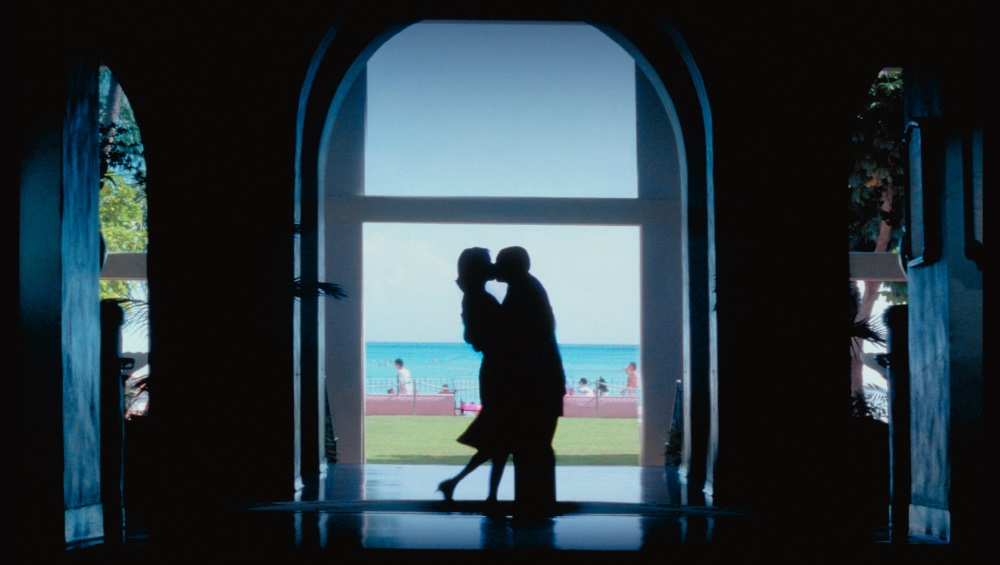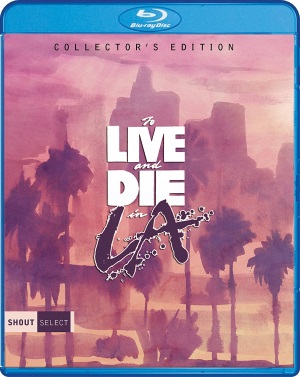 To Live and Die in L.A.: Collector’s Edition (Shout! Factory, Blu-ray) (1985) has aged well. While on the one hand you can hold it up as the quintessential expression of the era’s music video aesthetics and sleek, slick style, it’s also a distinctively singular, perfectly pitched action thriller from William Friedkin, a director in full command of his tools, including the high-octane style of neon surfaces, rapid editing and driving music.
To Live and Die in L.A.: Collector’s Edition (Shout! Factory, Blu-ray) (1985) has aged well. While on the one hand you can hold it up as the quintessential expression of the era’s music video aesthetics and sleek, slick style, it’s also a distinctively singular, perfectly pitched action thriller from William Friedkin, a director in full command of his tools, including the high-octane style of neon surfaces, rapid editing and driving music.
William L. Petersen was poised to make the leap from respected stage actor to intense screen star when he was cast as Secret Service agent Richard Chance, a rising star working in the Treasury Department who thrives on the adrenaline of the job. When his mentor, partner, and best friend is murdered while following up a lead on counterfeiter Rick Masters (a feral Willem Dafoe in his breakthrough performance), he goes rogue and drags his new partner, the smart but still green John Vukovich (John Pankow), into his increasingly reckless stunts. The film’s defining scene is the ingenious, nerve racking car chase that sends Chance and Vukovich up an off-ramp the wrong direction on the L.A. freeway, swerving and skidding around oncoming traffic, but it’s actually the climactic punch of a brilliantly composed car chase that begins in the no-man’s land under the freeway, carries us into traffic with a perfectly executed traveling crane that reveals the chase car closing in and sends us winding through the freight-strewn alleys of this warehouse district and into the empty L.A. basin, where a brace of cars close in and ups the stakes.
Adapted from the novel by former Secret Service man Gerald Petievich by Friedkin and Petievich, it’s a cynical and brutal portrait (both physically and emotionally) of the federal cops walking the edge and a cold portrayal of the power games between cops and feds, and cops and informants. Friedkin creates a jittery atmosphere of adrenaline and corruption and danger, enhanced by a surprisingly effective techno soundtrack by Wang Chung (the band’s best work) and draws savage performances from his entire cast, which includes Debra Feuer as Dafoe’s sexy lover, Darlanne Fluegel as the informant parolee that Chance keeps under his thumb, John Turturro as a courier arrested by Chance, and Dean Stockwell as the counterfeiter’s high-priced attorney. It’s shot by Robby Muller and his searing colors and hyper-real photography look superb.
The film has been on Blu-ray before. This Shout Select edition is newly remastered from a 4K scan of the original negative, supervised and approved by filmmaker Friedkin. The old MGM release was quite good but this edition offers greater detail, stronger blacks, and a slightingly more nuanced color palette.
New to this edition are interviews with actors William Peterson (20 minutes), Dwier Brown (8 minutes), and Debra Feuer (15 mins), stunt coordinator Buddy Joe Hooker (35 mins), and Jack Hues and Nick Feldman, aka Wang Chung (12 mins).
Carried over from the earlier Fox releases are the sharp and articulate commentary by Friedkin, the half-hour documentary “Counterfeit World: The Making of To Live and Die in L.A.,” and a deleted scene and an alternate ending. These were previously on DVD only in the Fox Blu-ray+DVD release so this is the first time these supplements are on Blu-ray.
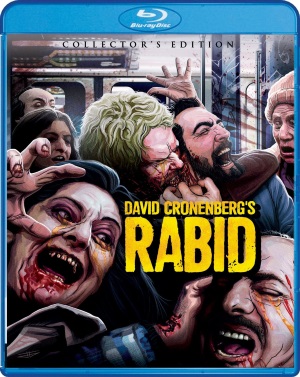 Rabid: Collector’s Edition (Scream Factory, Blu-ray) (1977), David Cronenberg’s sophomore feature, is another ingenious low budget horror film that turns disease into an evolutionary hiccup. This time an experimental skin graft mutates into a bloodsucking phallus and turns the recipient, Marilyn Chambers (in her mainstream movie debut), into a biological vampire come Typhoid Mary. With a phallic looking feeder located in her armpit, she embarks on a feeding frenzy leaves a virus in her victims, transforming them into a raving, ravenous, bloodthirsty maniacs. The entire city Montreal at Christmas erupts in green faced zombies foaming at the mouth and munching on bystanders as the virus spreads like an epidemic.
Rabid: Collector’s Edition (Scream Factory, Blu-ray) (1977), David Cronenberg’s sophomore feature, is another ingenious low budget horror film that turns disease into an evolutionary hiccup. This time an experimental skin graft mutates into a bloodsucking phallus and turns the recipient, Marilyn Chambers (in her mainstream movie debut), into a biological vampire come Typhoid Mary. With a phallic looking feeder located in her armpit, she embarks on a feeding frenzy leaves a virus in her victims, transforming them into a raving, ravenous, bloodthirsty maniacs. The entire city Montreal at Christmas erupts in green faced zombies foaming at the mouth and munching on bystanders as the virus spreads like an epidemic.
The roots of Cronenberg’s continuing fascination with disease, metamorphosis, and mutation are right here in this at times primitive but always inventive low budget horror film, and he’s ferocious in his portrait of a cannibal society reverting to pure, impulsive savagery. Chambers makes an anemic heroine, never really engaging the confused clash of human nature and primal survival instinct as she succumbs to the blood addiction while living in denial it, but even as Cronenberg bends over backwards to hide the sexual nature of her affliction he can’t help but appreciate the sheer weirdness of it all. As for the rest of it, Cronenberg creates a horrific vision of society savagely out of control and an ironic ending that would be cynical if it wasn’t so damnably effective. The shopping mall scenes of George Romero’s Dawn of the Dead may even owe a debt to this film, but Romero’s got nothing on Cronenberg’s Santa attack or the haphazard chaos of martial law’s armed response. If the feeders don’t get you, the trigger happy soldiers will.
There has never been a satisfactory version of Rabid on DVD and it has never been on Blu-ray before. This Scream Factory release, newly remastered from a 2K scan of the original negative, is more than an upgrade. It is definitive, or as close as we’re likely to get.
The commentary track by David Cronenberg is not new—it’s carried over from the 2004 DVD from Somerville House / Ventura—but it is great. Cronenberg is one of the most consistently introspective, observant, and informative directors on commentary tracks and he easily shifts back and forth from discussing production details (from the perspective of a veteran director looking back on the challenges of his first efforts—”The low budget horror films… were my film school, really”) to discussing the philosophy and ideas behind his stories (“Technology as an extension of the human body”).
There is a second commentary track from Cronenberg expert William Beard, which was originally recorded for the Arrow Blu-ray release in Britain, plus a new video interview with actress Susan Roman and a new audio-only interview with adult film historian Jill C. Nelson and Ken Leicht, who was Marilyn Chambers’ personal appearances manager, which plays sort of like another commentary track even though it focuses on Chambers rather than on the movie.
There is the 26-minute video essay “From Stereo to Video” from film historian Caelum Vatnsdal that focuses on Cronenberg’s early career up to Videodrome, plus archival interviews with David Cronenberg (21 mins, from the Somerville House / Ventura DVD) and producers Ivan Reitman (12 mins) and Don Carmody (16 mins), an animated gallery of stills and artwork, and a trailer, TV spot, and radio ads.
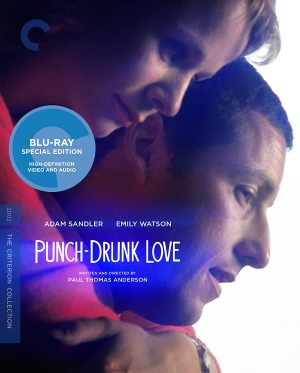 Punch-Drunk Love (Criterion, Blu-ray, DVD) – Paul Thomas Anderson, fresh off the critical successes of Boogie Nights and Magnolia, wrote Punch-Drunk Love (2002) for Adam Sandler while he was riding high on the success of doofus comedies. He channels the familiar Sandler personas—the meek boy-man, the repressed powerkeg who explodes with uncontrollable rage, the mumble mouth goofball, the socially retarded misfit—into a compassionate portrait and gives Sander an adult romance. Sandler’s Barry Egan, a salesman of novelty items, is a man living in the controlling, teasing, smothering presence of his sisters who spent their lives purposely humiliating him and now continue to do it as a matter of course. Emily Watson is the woman who reaches through the wall that this man has cocooned himself in and reassures him in a way that makes her every man’s dream woman and provides the safety to reveal the human being under the comic tics.
Punch-Drunk Love (Criterion, Blu-ray, DVD) – Paul Thomas Anderson, fresh off the critical successes of Boogie Nights and Magnolia, wrote Punch-Drunk Love (2002) for Adam Sandler while he was riding high on the success of doofus comedies. He channels the familiar Sandler personas—the meek boy-man, the repressed powerkeg who explodes with uncontrollable rage, the mumble mouth goofball, the socially retarded misfit—into a compassionate portrait and gives Sander an adult romance. Sandler’s Barry Egan, a salesman of novelty items, is a man living in the controlling, teasing, smothering presence of his sisters who spent their lives purposely humiliating him and now continue to do it as a matter of course. Emily Watson is the woman who reaches through the wall that this man has cocooned himself in and reassures him in a way that makes her every man’s dream woman and provides the safety to reveal the human being under the comic tics.
The story constantly twists into unexpected territory (a phone sex scam turns ugly and predatory) and Anderson pushes it with a camera that at times slips the images into uncomfortably off-balance compositions, and at others whips around the whirlwind of activity with a violence that could cause motion sickness and a soundtrack that seems to drown the viewer. Needless to say it left fans of Sandler’s doofus man-boy comedies scratching their heads—it’s not the only film that gives Sandler a more complex character but it is certainly the strangest—and Watson’s character is denied the same complications and depth of Sandler, but it is still weird in all the best ways, a film of unexpected bounces and unusual shadings. And it won of the Best Director Prize at the 2002 Cannes Film Festival. Philip Seymour Hoffman, Luis Guzman, and Mary Lynn Rajskub co-star.
The Criterion Blu-ray and DVD releases feature a new 4K digital transfer (supervised by Anderson). New to this release are new interviews with composer Jon Brion (28 minutes) and curators Michael Connor and Lia Gangitano (discussing the art of Jeremy Blake, which is featured in the film; 21 minutes), a new 10-minute featurette with behind-the-scenes footage of scoring sessions for the film’s soundtrack at Abbey Road studios, cast and creator press interviews and press conference from the Cannes Film Festival debut, and an NBC News interview from 2000 with David Phillips, “the pudding guy,” which in part inspired the film.
Carried over from the previous DVD release are two deleted scenes (including one lengthy bit with Barry fielding a barrage of phone calls from his sisters that will make you curl up with anxiety), the impressionistic 12-minute “Blossoms and Blood” (a gentle short film made up of alternate takes, Jeremy Blake artwork, and Jon Brion’s music), 12 Scopitones (short scenes and images set recut to music from the film), a “Mattress Man” commercial, additional artwork by Jeremy Blake, and trailers. The accompanying fold-out insert features an essay by Miranda July.
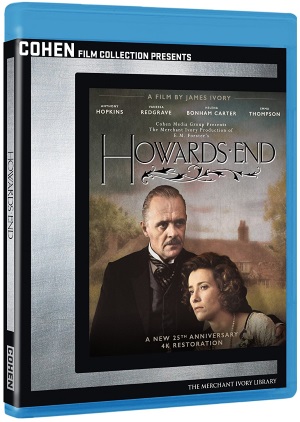 Howards End (Cohen, Blu-ray, DVD) (1992) Anthony Hopkins is the conservative patriarch of an old-money family in early 20th century England, Emma Thompson is a free-thinking woman befriended by his dying wife (Vanessa Redgrave, in an incandescent performance), and Helena Bonham Carter is Thompson’s younger sister, an even freer spirit, in the Merchant-Ivory adaptation of the E.M Forster novel. Directed by James Ivory from a screenplay by Ruth Prawer Jhabvala and produced by Ismail Merchant, it’s an impeccably elegant satire of Edwardian England where a plot by snooty upper-class conservative becomes hopelessly intertwined in a complicated story. It was the Merchant-Ivory’s third Forster adaptation and it is both elegant and nuanced, a drama that encompasses class, politics, adultery, marriage, murder, and ultimately the driest irony the intolerant aristocratic snobs could imagine. Samuel West, James Wilby, Prunella Scales, Jemma Redgrave, and Joseph Bennett co-star.
Howards End (Cohen, Blu-ray, DVD) (1992) Anthony Hopkins is the conservative patriarch of an old-money family in early 20th century England, Emma Thompson is a free-thinking woman befriended by his dying wife (Vanessa Redgrave, in an incandescent performance), and Helena Bonham Carter is Thompson’s younger sister, an even freer spirit, in the Merchant-Ivory adaptation of the E.M Forster novel. Directed by James Ivory from a screenplay by Ruth Prawer Jhabvala and produced by Ismail Merchant, it’s an impeccably elegant satire of Edwardian England where a plot by snooty upper-class conservative becomes hopelessly intertwined in a complicated story. It was the Merchant-Ivory’s third Forster adaptation and it is both elegant and nuanced, a drama that encompasses class, politics, adultery, marriage, murder, and ultimately the driest irony the intolerant aristocratic snobs could imagine. Samuel West, James Wilby, Prunella Scales, Jemma Redgrave, and Joseph Bennett co-star.
The two-disc 25th Anniversary edition is mastered from a new 4K restoration and features commentary by film critics Wade Major and Lael Lowenstein. The second disc is home to the rest of the supplements. James Ivory is interviewed by Laurence Kardish (the former Senior Curator of Film at MOMA) (26 minutes), engages in a post-screening Q&A moderated by film critic Michael Koresky (27 minutes), and is interviewed at Cannes with Vanessa Redgrave (8 minutes), all recorded in 2016 for the 25th anniversary re-release. Carried over from the previous DVD release are the 40-minute documentary “Building Howards End” and the featurette “The Design of Howards End” (9 minutes) and archival promotional featurette from 1992. There’s also a tribute to Ismail Merchant from James Ivory (12 minutes), trailers, and an accompanying booklet with short essays and artwork.
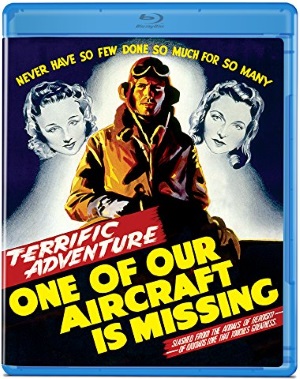 One of Our Aircraft is Missing (Olive, Blu-ray, DVD), directed by Michael Powell in partnership with co-producer and screenwriter Emeric Pressburger (who collaborated under the name “The Archers”), the 1942 feature “One of Our Aircraft is Missing” is one of the great “trapped behind enemy lines” films of World War II and a superb piece of propaganda filmmaking that is dramatically engaging as well as rousing.
One of Our Aircraft is Missing (Olive, Blu-ray, DVD), directed by Michael Powell in partnership with co-producer and screenwriter Emeric Pressburger (who collaborated under the name “The Archers”), the 1942 feature “One of Our Aircraft is Missing” is one of the great “trapped behind enemy lines” films of World War II and a superb piece of propaganda filmmaking that is dramatically engaging as well as rousing.
Like so many of his fellow British directors, Powell was charged with making films charged with a patriotic spirit during World War II. The title comes from a phrase that was familiar to British viewers of the time—it was used by radio broadcasters when RAF planes were downed or unaccounted for—and here refers to the crew of the bomber “B for Bertie” who parachute into occupied Netherlands when their craft is shot down. The drama chronicles their escape, masterminded and guided by the Dutch Resistance, notably the efforts of two women (played by Pamela Brown and Googie Withers) who risk their lives to get the British crew to the North Sea.
Powell and Pressburger were meticulous in their portrayal of all elements of the film, from the interactions of the bomber crew during their mission to the details of hiding and moving the British airmen in disguise passed German checkpoints. Powell opens the film with a mystery and a spectacular crash and follows it with a compelling drama delivered with creative storytelling—clever visual credits for the crew, a jump back in time to set the story, inventive sound design with a dense soundtrack and no musical score—and excellent performances that underplay the drama. A solid cast of British actors—Godfrey Tearle, Eric Portman, Hugh Williams, Bernard Miles, Hugh Burden, Emrys Jones—play the crewman and Peter Ustinov makes his feature debut as a Dutch priest in the Resistance. It earned two Oscar nominations and is quite rightly celebrated as one of the great British films of the 1940s.
No supplements.
Also new:
 Labyrinth: 30th Anniversary Edition (Sony, Blu-ray, 4K Ultra HD) Jim Henson remains best known for the humorous side of the Muppets, from Sesame Street to The Muppet Movie, but his works of fantasy are the most imaginative and, it seems, personal films of his career. Labyrinth draws inspiration from the puzzles, puns, and magic of Lewis Carroll for an adolescent “Alice in Wonderland” and a fantastic landscape that, at times, has all the skewed logic of an Escher sketch. It has been newly remastered in 4K for a 4K Ultra HD edition and a 30th anniversary Blu-ray edition with all new supplements: the featurettes “Reordering Time: Looking Back at Labyrinth” (9 minutes), “The Henson Legacy” (10 minutes), and the short “Remembering The Goblin King” remembrance of David Bowie, plus an anniversary Q&A with Brian Henson, Karen Prell, Dave Goelz, and actress Shari Weiser, moderated by Adam Savage (40 minutes). Carried over from the earlier Blu-ray release are commentary by conceptual designer Brian Froud, a picture-in-picture track “The Storytellers,” the 50-minute documentary “Inside the Labyrinth,” an engrossing, detailed behind the scenes look at the production originally produced for TV by Henson Productions, and the 27-minute “Journey Through the Labyrinth: The Quest for Goblin City,” all in SD quality.
Labyrinth: 30th Anniversary Edition (Sony, Blu-ray, 4K Ultra HD) Jim Henson remains best known for the humorous side of the Muppets, from Sesame Street to The Muppet Movie, but his works of fantasy are the most imaginative and, it seems, personal films of his career. Labyrinth draws inspiration from the puzzles, puns, and magic of Lewis Carroll for an adolescent “Alice in Wonderland” and a fantastic landscape that, at times, has all the skewed logic of an Escher sketch. It has been newly remastered in 4K for a 4K Ultra HD edition and a 30th anniversary Blu-ray edition with all new supplements: the featurettes “Reordering Time: Looking Back at Labyrinth” (9 minutes), “The Henson Legacy” (10 minutes), and the short “Remembering The Goblin King” remembrance of David Bowie, plus an anniversary Q&A with Brian Henson, Karen Prell, Dave Goelz, and actress Shari Weiser, moderated by Adam Savage (40 minutes). Carried over from the earlier Blu-ray release are commentary by conceptual designer Brian Froud, a picture-in-picture track “The Storytellers,” the 50-minute documentary “Inside the Labyrinth,” an engrossing, detailed behind the scenes look at the production originally produced for TV by Henson Productions, and the 27-minute “Journey Through the Labyrinth: The Quest for Goblin City,” all in SD quality.
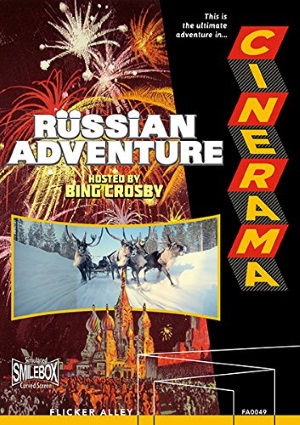 Cinerama’s Russian Adventure (Flicker Alley, Blu-ray+DVD) (1966), the final Cinerama feature released in the three-strip presentation was actually shot in a Russian three-camera process called Kinopanaroma (Russia’s proprietary version of the American Cinerama process). A lavish travelogue through the Soviet Union, it was essentially a greatest hits from six Kinopanorama films produced for Soviet audiences, reedited for American release and featuring folksy narration from Bing Crosby, who plays the genial host. It opens on the dramatic rush of the camera mounted in a dog sled speeding through the snows of Northern Russia and jumps between natural wonders (the Volga River, a wild antelope round-up, an underwater dive into the Sea of Japan) and cultural treasures (the Moscow Circus, the Bolshoi Ballet, the acrobatic Moiseyev Dance Company). There’s no Cold War tension here. The footage is all shot by Soviet filmmakers for Soviet audiences and the American narration is free of any social or political commentary. Think of it as a cultural exchange between wary nations, not so much a documentary as a visual showcase of Russian wonders.
Cinerama’s Russian Adventure (Flicker Alley, Blu-ray+DVD) (1966), the final Cinerama feature released in the three-strip presentation was actually shot in a Russian three-camera process called Kinopanaroma (Russia’s proprietary version of the American Cinerama process). A lavish travelogue through the Soviet Union, it was essentially a greatest hits from six Kinopanorama films produced for Soviet audiences, reedited for American release and featuring folksy narration from Bing Crosby, who plays the genial host. It opens on the dramatic rush of the camera mounted in a dog sled speeding through the snows of Northern Russia and jumps between natural wonders (the Volga River, a wild antelope round-up, an underwater dive into the Sea of Japan) and cultural treasures (the Moscow Circus, the Bolshoi Ballet, the acrobatic Moiseyev Dance Company). There’s no Cold War tension here. The footage is all shot by Soviet filmmakers for Soviet audiences and the American narration is free of any social or political commentary. Think of it as a cultural exchange between wary nations, not so much a documentary as a visual showcase of Russian wonders.
The restoration shows minor damage and brief registration issues but is otherwise lovely and it is presented in the “smilebox” format to simulate the curved screen of theatrical showings. Features two bonus Cinerama shorts and an interview among the supplements, plus a booklet with a miniature reproduction of the original program.
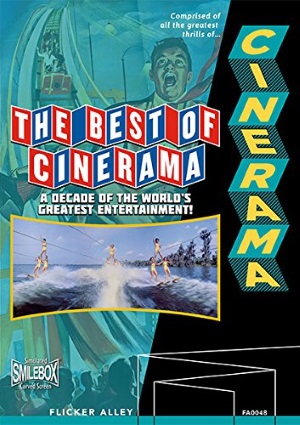 The Best of Cinerama (Flicker Alley, Blu-ray+DVD) (1962) is the American greatest hits collection from five Cinerama features (This is Cinerama, Cinerama Holiday, Seven Wonders of the World, Search for Paradise, and South Seas Adventure). I have not watched this one but the set features commentary by Cinerama historian David Coles, four bonus Cinerama shorts, plus interviews, archival featurettes, and slideshows, and is also presented in the “smilebox” format.
The Best of Cinerama (Flicker Alley, Blu-ray+DVD) (1962) is the American greatest hits collection from five Cinerama features (This is Cinerama, Cinerama Holiday, Seven Wonders of the World, Search for Paradise, and South Seas Adventure). I have not watched this one but the set features commentary by Cinerama historian David Coles, four bonus Cinerama shorts, plus interviews, archival featurettes, and slideshows, and is also presented in the “smilebox” format.

